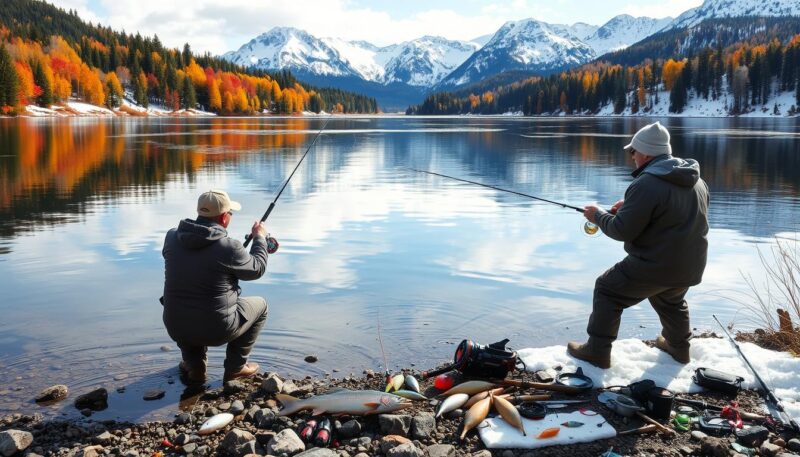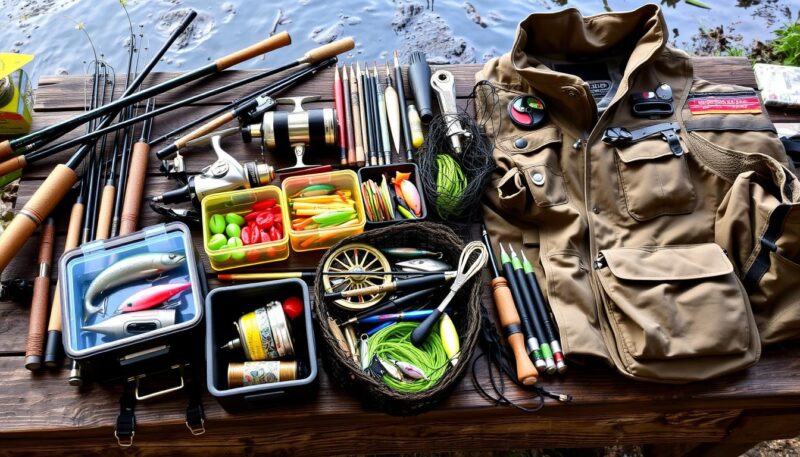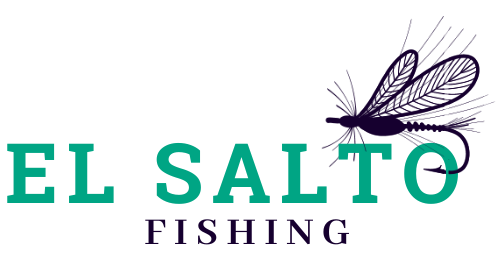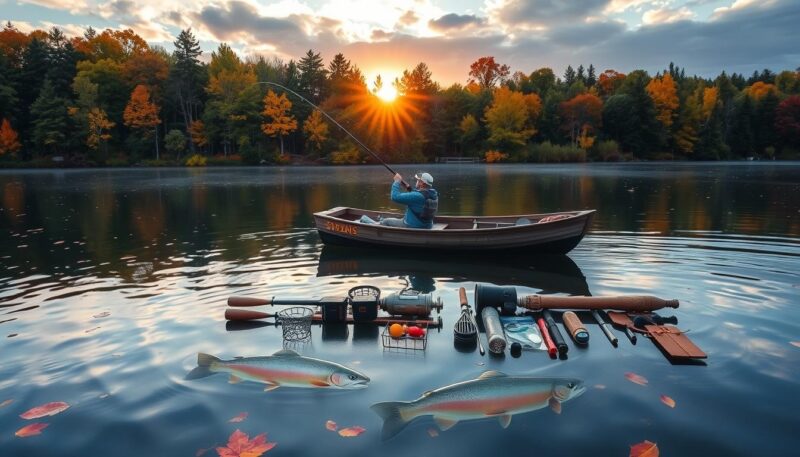Fishing for trout is a rewarding and accessible pastime that appeals to anglers of all skill levels. Whether you’re a seasoned veteran or just dipping your toes into this exciting world, understanding the basics can significantly enhance your experience. One common misconception is that trout fishing is an elite sport reserved for the wealthy; however, many anglers successfully catch trout using simple techniques and affordable gear. With the right guidance, you can make the most of your fishing trips.
To embark on your trout fishing journey, it’s essential to grasp the unique characteristics of the various trout species and their habitats. Knowing where to find rainbow trout or lake trout is crucial for successful fishing. In this guide, you’ll learn how to fish for trout effectively throughout the year. We’ll explore essential trout fishing tips, seasonal strategies, and the best gear to use. By the end, you’ll have valuable insights that will empower your fishing endeavors and improve your success rate when catching trout year-round.
Understanding Trout Species and Their Habitats
Knowledge of the various types of trout can enhance your fishing experience. A deeper understanding of trout species and their specific habitats will provide insights into where to find them and what strategies work best. Each species has its own characteristics that dictate their environmental preferences.
Types of Trout to Target
Anglers often target multiple types of trout, including native, wild, and stocked variations. The following table highlights the key traits and preferences of prominent trout species found across the United States:
| Trout Species | Habitat Preferences | Feeding Behavior | Best Fishing Times |
|---|---|---|---|
| Brown Trout | Deep, dark spots (undercut banks, plunge pools) | Nocturnal feeders, prefers larger prey | Early mornings, late afternoons |
| Rainbow Trout | Moving waters, strong currents | Daytime feeders, active in warmer weather | Throughout the day |
| Brook Trout | Smaller pockets, isolated edges | Aggressive feeders, targets smaller prey | Warm sunny conditions |
| Cutthroat Trout | Primarily streams of the western U.S. | Variable, depending on life stage | Early morning, cooler hours |
| Marble Trout | Adriatic Sea basin rivers | Active feeders, varying diet | Daytime during warmer months |
Common Habitats for Trout Fishing
Trout habitats range from streams and rivers to lakes, each attracting various trout species based on environmental conditions. To effectively target trout, focus on areas that feature:
- Streams with current providing oxygenation and food delivery for active species.
- Lakes with submerged structures offering cover for more solitary types like brown trout.
- Rivers with pools and eddies where larger fish prefer to reside.
- Shaded areas during warm weather that promote hatches and feeding activity.
Understanding these habitats can significantly increase your catch rate. Utilize online resources and engage with local fishing communities to identify the best fishing locations tailored to the trout species you wish to target.
How to Fish for Trout: Techniques and Tactics
Understanding the best fishing techniques for trout can significantly improve your fishing experience, whether you are a beginner or an experienced angler. Different methods cater to various preferences and skill levels. By mastering conventional tackle, diving into advanced fly fishing techniques, and applying seasonal trout fishing strategies, you can enhance your chances of landing that elusive trout.
Conventional Tackle for Beginners
For those just starting, conventional tackle provides an accessible approach to trout fishing. Using gear such as spinning rods and reels, you can easily manipulate lures and baits. Here are some straightforward techniques:
- Utilize lures like spinners, spoons, and crankbaits that mimic the natural movement of fish.
- Employ live bait such as worms or salmon eggs, especially effective in waters with stocked trout.
- Experiment with bobber rigs, allowing you to fish at varying depths—ideal for lakes and ponds.
It’s essential to remember that trout typically feed near the bottom and around structures in lakes, so positioning your bait effectively can improve your success rate.

Advanced Fly Fishing Techniques
For anglers looking to up their game, advanced fly fishing for trout is both an art and science. This technique focuses on matching the hatch, a process that involves selecting flies that resemble the insects trout naturally feed on during different seasons:
- Observe the water, identifying active hatches and adjusting your fly selection accordingly.
- Use techniques like dry fly fishing to present your bait on the surface, which can draw more bites.
- Learn to cast upstream, allowing your line to drift naturally with the current, enhancing realism.
Understanding the feeding habits and preferences of trout can lead to much higher catch rates when utilizing fly fishing techniques.
Seasonal Fishing Methods
Timing is crucial in seasonal trout fishing, with each season presenting unique opportunities. Below is a comparative breakdown of strategies based on the time of year:
| Season | Best Fishing Techniques | Key Considerations |
|---|---|---|
| Spring | Focus on shallow waters with worms or Powerbait. | Trout are more active as temperatures rise. |
| Summer | Fish in cooler mornings or evenings using spinners. | Targets are deeper waters due to heat. |
| Fall | Utilize lures in both shallow and deep waters. | Trout feed actively before wintering. |
| Winter | Target slow-moving waters with live bait or jigs. | Fish often congregate in deep pools. |
By adapting your fishing techniques to the seasons, you can ensure a more productive trout fishing experience throughout the year.
Choosing the Right Gear for Successful Trout Fishing
Selecting the right equipment is crucial for a successful trout fishing experience. Understanding essential trout fishing gear, the best trout fishing bait options, and identifying the best fishing locations for trout enhance your chances of landing that prized catch. Equip yourself properly with the right knowledge and tools.
Essential Trout Fishing Gear
Your trout fishing gear starts with selecting an appropriate rod and reel combination. For small streams, a rod length of 6 to 7 feet works best, while for open waters like lakes or reservoirs, aim for an 8 to 9 feet rod. Opt for light to medium power rods to enhance the detection of subtle bites. Spinning reels are highly versatile, suitable for various fishing techniques, while fly reels are perfect for specialized methods.
Use fluorocarbon lines for their near-invisibility in water and the extra sensitivity they provide. Braided lines deliver exceptional strength while maintaining a small diameter. It’s essential to have a variety of hooks, lures, and weights, including split shot and egg sinkers, to suit different fishing conditions. Don’t forget a tackle box to organize your gear and a fishing net to land trout safely.
Top Trout Fishing Baits
Effective trout fishing bait can vary based on your techniques. Natural baits like worms, minnows, and salmon eggs are always a favorite. For anglers who prefer artificial lures, spinners, spoons, and soft plastic baits are highly recommended. Seasoned anglers often report greater success with smaller lures, particularly when targeting stocked trout in various environments.
Choose hooks based on the bait or lure used, with size 10 or 12 baitholder hooks recommended for doughballs of Power Bait. The right selection of bait not only attracts trout but also increases your chances of a successful outing.
Best Fishing Locations for Trout
Identifying the best fishing locations for trout is fundamental for an enjoyable experience. In the Mid-Atlantic region, trout fishing typically begins around mid-March to early April, focusing on stocked rainbow, brown, and golden trout. Stay mobile and adaptable to different tactics to locate active fish at stocked ponds, lakes, and rivers.
As you research potential fishing spots, look for areas known for good trout populations, such as local lakes with regular stocking schedules. These locations often provide abundant harvests and fast action, making them ideal for both beginner and experienced anglers.

| Gear Type | Recommended Length | Recommended Power |
|---|---|---|
| Rods for Small Streams | 6 to 7 feet | Light to Medium |
| Rods for Open Waters | 8 to 9 feet | Light to Medium |
| Reel Type | – | Spinning/Fly |
| Line Type | – | Fluorocarbon/Braided |
| Hooks | – | Size 10 or 12 |
Conclusion
Successful trout fishing is within reach for anglers throughout the year, regardless of skill level. By understanding the various trout species such as Rainbow, Brown, and Brook, along with their distinct feeding habits and preferred habitats, you can enhance your fishing strategies. These insights serve as a valuable foundation for employing effective trout fishing methods, ensuring that your time spent on the water is productive.
Equipping yourself with the right gear is equally crucial. A proper rod, reel setup, and bait tailored to your target species can significantly influence your success rates. Whether you opt for traditional bait or finesse your fly fishing technique, these fishing for trout tips will help you adapt to seasonal changes. Remember, consistent feeding times during spring and summer, as well as understanding the trout’s behavior during other seasons, will ultimately lead to captivating fishing experiences.
In conclusion, by applying the knowledge gained from this article, you are well-equipped to embark on your trout fishing journey. Embrace the excitement of recognizing diverse trout habitats and adjusting your methods accordingly to capitalize on feeding behaviors. With patience and practice, you’ll find that successful trout fishing can be a rewarding adventure in any season.

